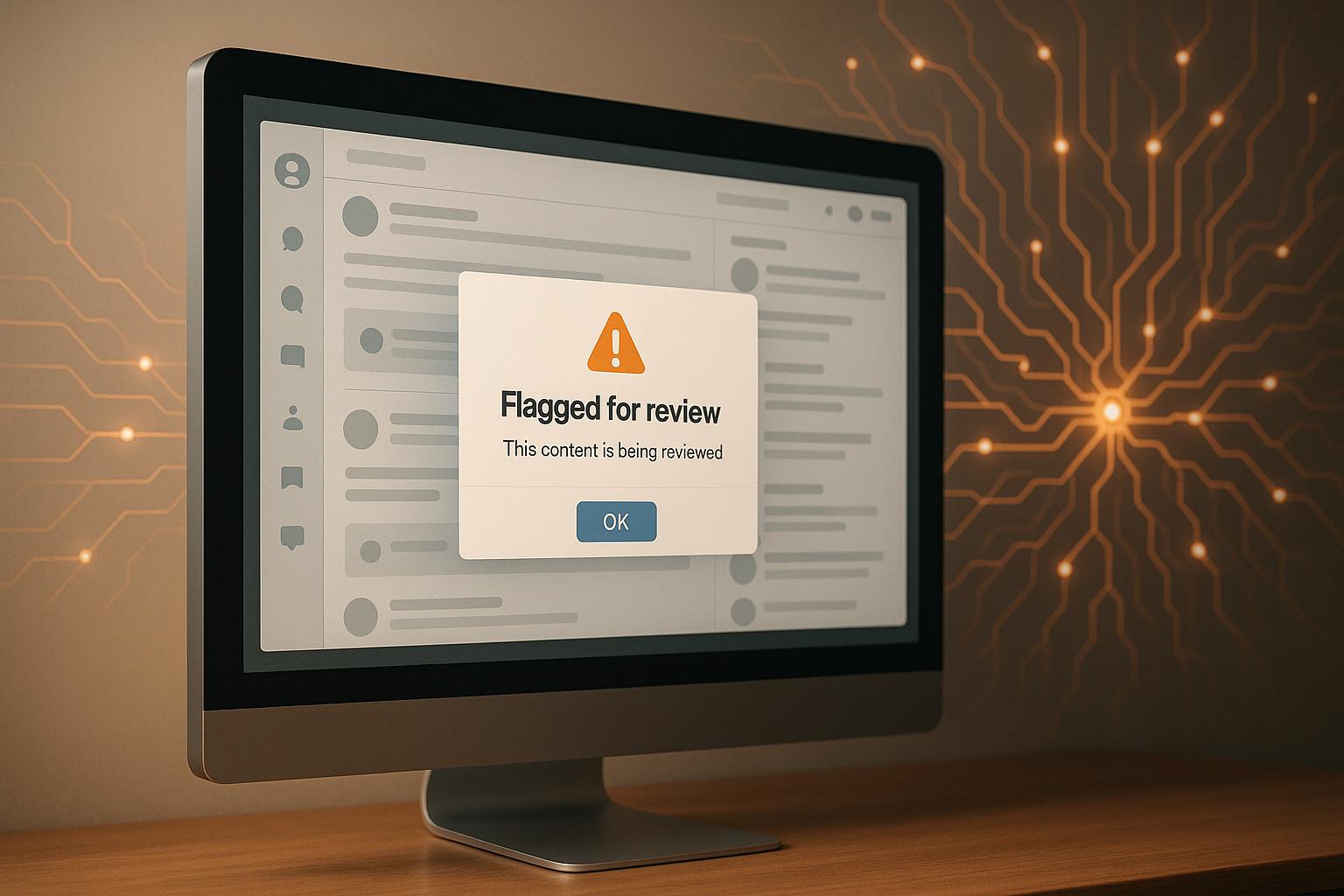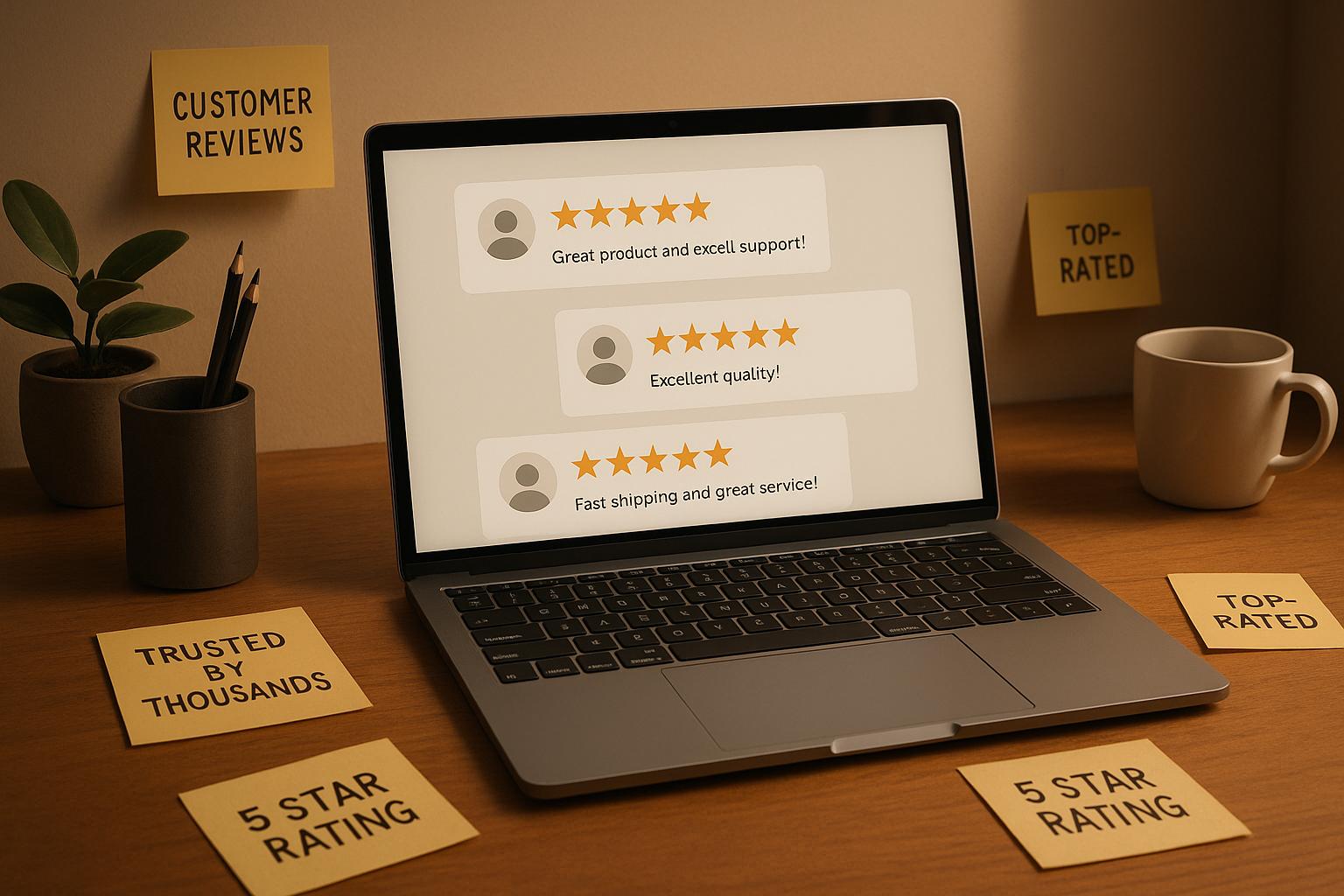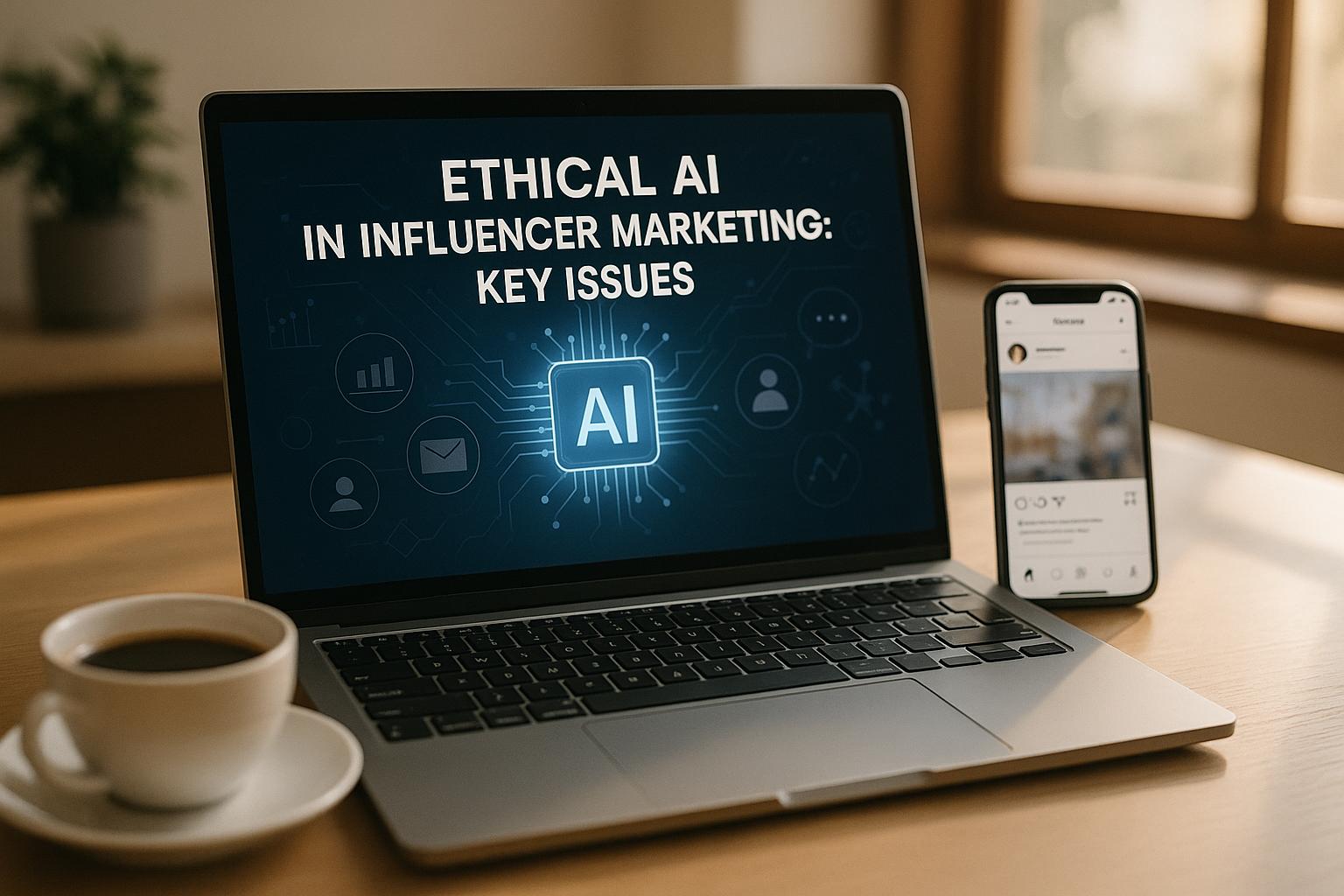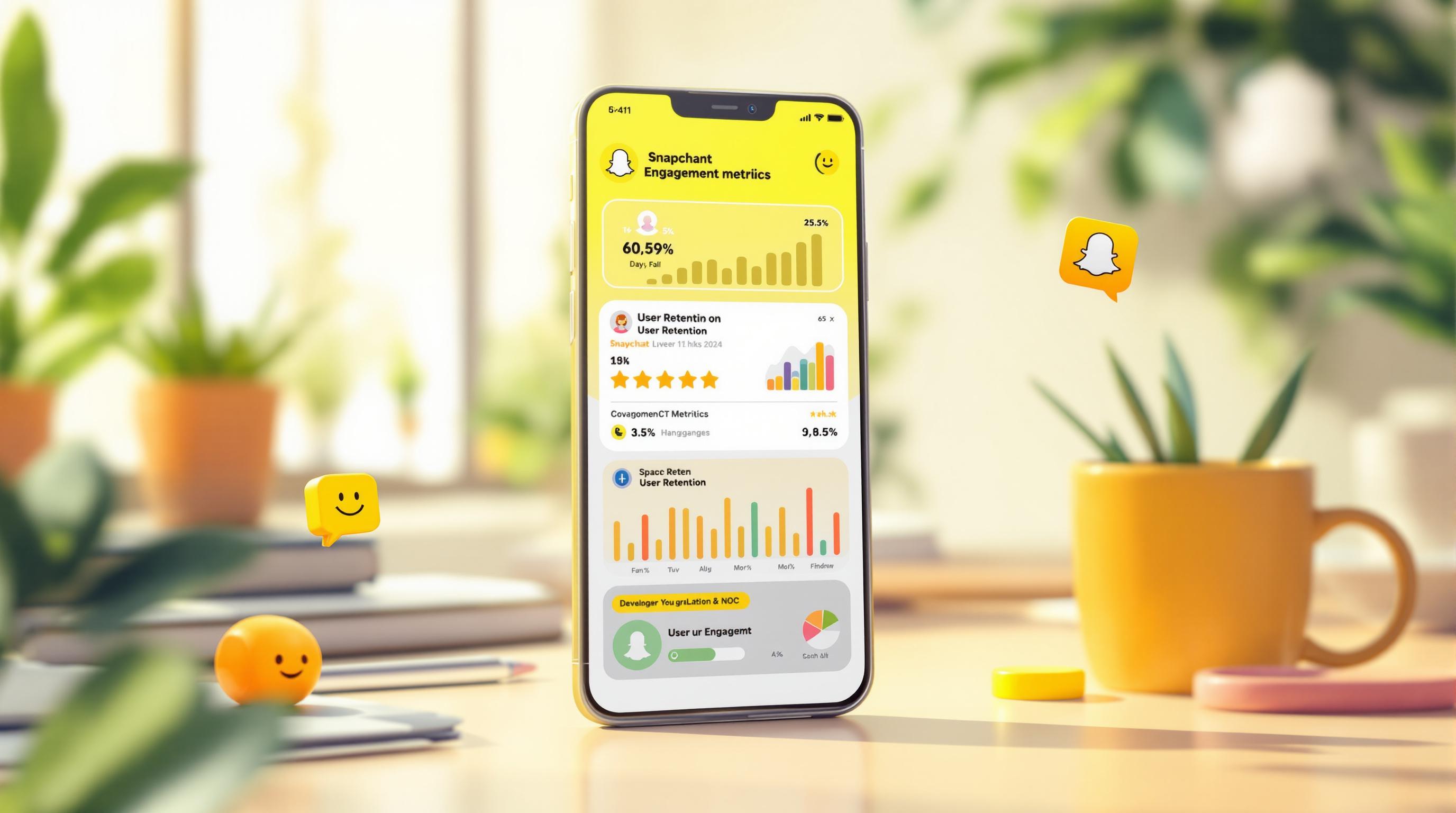
Real-time moderation is critical for managing the massive volume of user-generated content (UGC) flooding social media platforms daily. AI-powered tools are now essential for handling this task efficiently, ensuring harmful content is flagged or removed before it spreads. Here's what you need to know:
- Why It Matters: Platforms like YouTube, Instagram, and Twitter process millions of posts every day. Without effective moderation, harmful content can damage trust, violate regulations, and hurt platform growth.
- Challenges of Manual Methods: Human moderators and basic keyword filters struggle with scale, context, and speed, often missing threats like coded hate speech or deepfakes.
- AI Technologies in Moderation:
- Natural Language Processing (NLP): Analyzes text for context, tone, and intent to detect harmful language.
- Computer Vision: Reviews images and videos for inappropriate visuals, hate symbols, and deepfakes.
- Machine Learning (ML): Continuously improves moderation accuracy by learning from new threats and user behavior.
- Leading Tools: Platforms like Hive, WebPurify, and ActiveFence offer tailored solutions for text, image, and video moderation with varying levels of automation and human oversight.
- Benefits: AI moderation is faster, more scalable, and less prone to error than manual methods. It also helps platforms comply with legal standards and maintain user trust.
AI moderation isn’t perfect, but combining it with human oversight ensures a safer and more efficient way to manage UGC. Businesses must adopt these tools to keep up with the evolving digital landscape.
How to Build a Content Moderation Solution with AI
AI Technologies That Power Modern Moderation
The challenges of manual moderation have pushed the development of advanced AI technologies capable of processing content at incredible speeds. By blending various AI approaches, modern systems not only assist human moderators but also enable real-time moderation of user-generated content (UGC). With machine learning algorithms handling about 90% of initial content moderation tasks, understanding these technologies is crucial for any platform aiming to manage UGC effectively.
Natural Language Processing (NLP) for Text Analysis
Natural Language Processing (NLP) is at the heart of text-based content moderation, empowering computers to grasp the nuances of human language. Unlike basic keyword filters that can miss context, NLP analyzes the full meaning of posts, comments, and messages.
NLP processes informal language to accurately assess context and sentiment. It breaks down text into components, examining the tone, intent, and overall meaning. This allows it to differentiate between a harmless joke, a strong opinion, and truly harmful content.
Sentiment analysis plays a significant role by identifying whether text conveys positive, negative, or neutral emotions, helping flag potentially offensive material early. Entity recognition takes it a step further by spotting names, locations, or organizations to detect personal attacks or doxxing attempts. Additionally, text classification organizes content into categories, flagging posts that violate platform policies.
"The role of Natural Language Processing at Bodyguard is not to censor people from expressing themselves online but rather to promote a comment section that is free of harmful content and where meaningful exchanges can take place." - Bodyguard.ai
Modern NLP systems adapt quickly to the ever-changing language of the internet, including new slang and coded hate speech. By continuously monitoring and learning, NLP keeps up with evolving expressions and their meanings in specific online communities, ensuring moderation remains effective. While NLP excels at text analysis, computer vision steps in to handle visual content.
Computer Vision for Image and Video Content
While NLP focuses on text, computer vision tackles the complexities of moderating visual content. With over 720,000 hours of video and more than 3 billion images uploaded daily, manual review is simply impractical.
Computer vision systems analyze images and video streams frame by frame, using advanced algorithms to identify patterns, objects, and behaviors. These systems can detect inappropriate visuals, recognize hate symbols, flag copyrighted material, and even identify deepfakes - all in real time.
Major platforms rely on this technology to maintain content standards. For instance, CoStar uses Amazon Rekognition's Content Moderation API to review uploaded images for compliance. Dream11 processes thousands of media assets daily for its 100 million users, and ZOZO Inc. has cut its manual review workload by up to 40% through automated image analysis.
"By leveraging advanced AI-powered technologies, computer vision can analyze video streams in real time, identifying problematic content and triggering automated actions to address violations. For example, it can detect inappropriate visuals, recognize hate symbols and flag copyrighted material within seconds." - api4ai
These systems flag up to 95% of unsafe content, enabling human moderators to focus on complex cases that require judgment. This approach not only improves accuracy but also reduces the emotional toll on moderators who would otherwise face distressing visual material.
Machine Learning (ML) for Continuous Improvement
Machine learning (ML) plays a pivotal role in enhancing moderation accuracy by continuously adapting to new challenges. Unlike rigid, rule-based systems, ML algorithms evolve by learning from fresh data, user feedback, and shifting content trends, ensuring they keep pace with online behavior.
This adaptability comes from ongoing model updates. As new forms of hate speech, misinformation, and user behavior emerge, ML systems analyze these patterns and adjust their detection capabilities. This ensures even the most sophisticated threats are identified quickly.
One standout application of ML is anomaly detection. By using unsupervised learning, ML systems can spot unusual patterns in user behavior or content, catching threats that might evade traditional filters.
The market reflects the growing reliance on AI for moderation. AI in social media is projected to grow from $14 billion to $72 billion by 2029. This rapid expansion highlights ML's ability to handle the scale and complexity of modern UGC while continually improving through real-world application and feedback.
Leading AI-Powered UGC Moderation Tools
Modern platforms are now capable of processing millions of posts every minute, thanks to advancements in natural language processing (NLP), computer vision, and machine learning (ML) technologies. These tools provide scalable and precise moderation for user-generated content (UGC).
Popular Tools Overview
Building on the AI technologies discussed earlier, these tools offer tailored solutions for real-time UGC moderation, addressing a variety of business needs.
Hive
Hive is a fully automated platform that uses pre-trained models and AutoML to moderate text, images, videos, and audio. It operates without human review and offers transparent, usage-based pricing, starting with $50+ in free credits. Hive’s AI-exclusive approach makes it an efficient option for businesses looking for straightforward pricing and automation.
WebPurify
WebPurify combines AI automation with optional human review, creating a hybrid system that balances speed and accuracy. It moderates text, images, and videos, with pricing ranging from $5 to $50 per month. This flexibility allows businesses to escalate complex cases to human moderators when AI confidence levels are low.
Sightengine
Specializing in visual moderation, Sightengine offers detailed and customizable controls. Pricing starts at $29 per month for 10,000 operations and goes up to $399 for 200,000 operations. While it provides precise moderation workflows, it requires more technical integration compared to simpler plug-and-play solutions.
Stream
Stream incorporates moderation as part of its broader suite of tools for building social features. Pricing options range from pay-as-you-go plans to enterprise-level packages costing $50,000 annually. This makes Stream a strong choice for businesses looking to develop comprehensive social platforms rather than adding moderation as a standalone feature.
ActiveFence
ActiveFence goes beyond content moderation by integrating threat intelligence to prevent risks before they escalate. Supporting over 100 languages and various content formats, it focuses on proactive risk management. Pricing is enterprise-specific and requires direct consultation, reflecting its tailored approach to emerging threats.
Yotpo
Yotpo has shown impactful results for e-commerce platforms. For example, Sam Speller, the founder of Kenko Tea, shared how Yotpo positively transformed their business:
"Since integrating Yotpo, we've seen a 40% lift in review volume and a 22% lift in conversion rates when visitors read these AI-curated reviews. It brings up the exact words and qualities our prospective customers are searching for while still sounding authentic."
TINT
TINT focuses on UGC curation and rights management, using AI-driven moderation to save time. Angel Sanchez from Wanderlust Portraits highlighted its efficiency:
"TINT's AI-driven moderation and content rights management save dozens of hours, especially during high-volume travel seasons when customers are sharing in real time... For example, our campaign sharing real client vacation stories through TINT increased Instagram saves and led to at least five direct booking inquiries each month, providing a strong indicator of UGC's value."
Feature Comparison Chart
The table below outlines the key features of these platforms to help you make an informed decision:
| Provider | Text Moderation | Image Moderation | Video Moderation | Human Review Available | Custom Models | Dashboard Included | Pricing Transparency |
|---|---|---|---|---|---|---|---|
| Hive | ✅ | ✅ | ✅ | ❌ | ✅ (AutoML) | ✅ | ✅ |
| Stream | ✅ | ✅ | ✅ | ❌ | ✅ | ✅ | ✅ |
| WebPurify | ✅ | ✅ | ✅ | ✅ | ❌ | ✅ | ✅ |
| Sightengine | ✅ | ✅ | ✅ | ❌ | ✅ | ✅ | ✅ |
| CleanSpeak | ✅ | ✅ | ✅ | ❌ | ✅ | ✅ | ❌ |
| Checkstep | ✅ | ✅ | ✅ | ✅ | ✅ | ✅ | ❌ |
| ActiveFence | ✅ | ✅ | ✅ | ✅ | ✅ | ✅ | ❌ |
Choosing the Right Tool
Selecting the right moderation tool depends on your platform’s specific needs. For businesses looking for full automation and predictable costs, Hive and Stream offer extensive features with clear pricing. WebPurify is ideal for those who want AI efficiency paired with human oversight, while Sightengine is better suited for teams requiring fine-tuned control over detection settings.
For enterprise-level solutions, Checkstep and ActiveFence provide advanced capabilities like custom model training and proactive risk management. However, their pricing requires direct consultation due to the highly tailored nature of their services.
As the U.S. market for AI-powered moderation tools grows from $0.4 billion to $1.6 billion by 2030, businesses can expect ongoing innovation and competitive pricing in this space. When choosing a tool, consider factors like content volume, the types of content you need to moderate, and the technical complexity of implementation.
sbb-itb-3858882
Business Benefits of AI Moderation
AI-powered moderation is transforming how businesses manage content, offering clear advantages in efficiency, quality, and compliance.
Speed and Scalability
AI moderation eliminates bottlenecks by processing content up to 100 times faster than humans. With the average person generating 102 MB of data every minute, these systems leverage parallel processing to handle massive volumes and automatically scale with demand.
Real-time AI tools can flag or remove problematic content instantly, stopping issues before they escalate. Auto-scaling infrastructure adapts to sudden content spikes, while dynamic cloud computing ensures performance stays optimized without breaking the bank. This allows businesses to grow without needing to proportionally expand their moderation teams, cutting costs as platforms scale.
These capabilities not only improve efficiency but also enhance accuracy and compliance.
Better Accuracy and Less Bias
AI moderation reduces human error and addresses unconscious bias in content review. For instance, Microsoft’s facial recognition audit increased accuracy for darker-skinned women from 79% to 93% by rebalancing training data and using adversarial debiasing techniques.
Techniques like curating diverse training datasets and applying data augmentation help minimize biases. Adversarial debiasing, in particular, trains AI models to actively identify and correct biases, using adversarial neural networks to create fairer predictions.
Still, human involvement remains essential. As Manish Jain, Chief Marketing & Strategy Officer at Fusion CX, explains:
"AI might be the fastest learner in the room, but it takes a human touch to understand the heartbeat of a community".
This balance between AI precision and human judgment builds trust - a vital ingredient for business growth.
Meeting Legal and Brand Standards
AI moderation also plays a critical role in ensuring legal compliance and protecting brand integrity. According to Bynder's State of DAM report, top concerns for brands include content quality control (55%), risk management (50%), and compliance (47%).
The risks of poor moderation are serious. In 2021, Roblox faced backlash after a sexually explicit game was discovered on its platform, exposing flaws in its auto-moderation systems.
AI systems enforce consistent content guidelines, quickly identifying issues. The growing reliance on these technologies is reflected in market trends, with the AI-powered content moderation market projected to hit $14 billion by 2029.
However, as Manisha Mehta, Bynder’s Global PR and Communications expert, points out:
"While AI is certainly efficient, this doesn't mean it is risk-free and without proper governance, it can introduce misaligned messaging and even reputational risks".
Bynder’s report underscores the importance of human oversight, with 90% of respondents deeming it essential to protect brand identity, and 54% labeling it as "very important". The most effective moderation strategies combine AI automation with clear policies, hybrid systems, and regular updates to maintain transparency. This approach helps filter harmful content while meeting evolving legal and brand requirements.
How to Implement AI-Driven Moderation
To effectively implement AI-driven moderation, you need a well-balanced approach that combines automation with human oversight. This ensures scalability without compromising community trust. For real-time success, focus on clear policies, a hybrid system, and constant refinement.
Create Clear Moderation Policies
Clear and detailed moderation policies are the backbone of any successful AI-driven system. Without them, even the most advanced tools can falter when making decisions that align with your brand's values. Your policies should address specific content categories, such as personal information sharing, hate speech, bullying, inappropriate language, external links, and advertising. Concrete examples of acceptable and unacceptable behavior are key to avoiding ambiguity. For instance, instead of a vague ban on "hate speech", explicitly state that content targeting individuals based on race, religion, or sexual orientation will not be tolerated.
A great example of this is Reddit’s evolving community guidelines. They clearly outline boundaries and use a tiered penalty system - from content removal to account suspensions. This approach not only builds trust but also reduces confusion. Communicating consequences and offering an appeal process further reinforces fairness and transparency.
To stay relevant, update your policies regularly, incorporating feedback from your community and addressing new challenges as they arise.
Use Hybrid Systems
AI alone isn’t enough for handling complex content moderation decisions. The best systems combine the speed and efficiency of AI with the nuanced judgment of human moderators.
For example, Bazaarvoice uses AI to moderate 73% of user-generated content (UGC) within seconds, leaving the remaining 27% for human review. This setup ensures that the more sensitive or ambiguous cases get the attention they deserve. Human moderators also play a vital role in labeling data, which helps train and refine AI models to meet the platform's specific needs.
AI can act as the first line of defense, automatically approving straightforward content while flagging questionable material for human review. Take Grindr’s PartnerHero system as an example: it uses AI tools integrated into trust and safety workflows to handle large-scale moderation while ensuring fairness in complex cases. In one instance, an AI flagged a post about postpartum depression due to "self-harm" keywords. A human moderator stepped in, recognized the post as a call for support, and provided helpful resources instead of removing it. This kind of collaboration maximizes both efficiency and empathy.
By blending AI and human oversight, you create a system that’s not only efficient but also adaptable to unique situations.
Regular Updates and User Transparency
AI moderation systems need constant updates to tackle evolving threats, new slang, and shifts in societal norms. Feedback mechanisms are also essential - they let users report errors and suggest improvements, creating a continuous learning loop.
Transparency is another critical factor. Microsoft sets a strong example with its Responsible AI Transparency Report, which details its AI practices and decision-making processes. Similarly, OpenAI shares insights through research papers that explain its AI developments. As highlighted in the Zendesk CX Trends Report 2024:
"Being transparent about the data that drives AI models and their decisions will be a defining element in building and maintaining trust with customers." - Zendesk CX Trends Report 2024
To maintain trust, establish clear communication channels to explain moderation practices and decisions. Let users know how they can appeal decisions and how their feedback is used to improve the system. This openness reduces frustration and helps users better understand your guidelines.
| Best Practice | How to Implement |
|---|---|
| Clear Communication | Keep users informed about AI moderation processes, data usage, and decision-making. |
| Regular Updates | Continuously refine AI models to handle new threats and biases. |
| Feedback Mechanisms | Allow users to report errors and suggest improvements. |
| Documentation | Provide detailed records of AI decision-making and data sources. |
| Regular Audits | Periodically evaluate AI performance, fairness, and accuracy. |
Regular audits are essential for identifying patterns in false positives or negatives and adjusting models as needed. Bringing diverse perspectives into these reviews can also help uncover and address potential biases. By combining regular updates, transparency, and user input, you can maintain an effective and trustworthy moderation system.
The Future of AI in UGC Moderation
The role of AI in moderating user-generated content (UGC) is evolving rapidly. With projections estimating 463 exabytes of data generated daily by 2025 and 78% of all online content being user-generated by 2033, the need for advanced moderation systems has never been greater. These advancements build on current AI capabilities and push the boundaries of what’s possible in content moderation.
Future AI systems will refine existing methods to handle content more effectively. For instance, improvements in Natural Language Processing (NLP) will allow systems to grasp context and subtle nuances in text, while advances in Computer Vision algorithms will enhance the detection of harmful visual content in images and videos. These upgrades aim to minimize false positives and improve the identification of genuinely problematic material.
Proactive AI systems are already intercepting harmful content before it’s posted, creating safer online spaces and easing the workload for human moderators. Looking ahead, AI will become even better at distinguishing harmful content from legitimate discussions by leveraging refined sentiment analysis and greater contextual awareness. This progress will help platforms strike a balance between encouraging open dialogue and protecting users from real threats.
Collaboration between AI and human moderators will remain essential. As Ciaran Connolly, Founder of ProfileTree, explains:
"AI isn't a silver bullet, but when teamed with human intuition, it brings us closer to a moderated online world that respects both freedom and safety."
Another exciting development is personalized moderation, which allows users to customize content filters according to their preferences. This approach not only respects individual boundaries but also ensures a safer environment for all.
For businesses, adopting AI-powered moderation tools is no longer optional - it’s a necessity. These systems help build trust, ensure regulatory compliance, and efficiently handle the growing volume of UGC. Companies that fail to adapt risk falling behind in an increasingly competitive social media landscape.
Ethical considerations are also becoming a central focus. Transparency, bias reduction, and explainability are crucial for ensuring that moderation systems remain fair and reliable as they evolve. This emphasis on responsible AI development will help maintain trust in these technologies.
AI moderation is also set to expand into new frontiers, including augmented and virtual reality content. As these immersive technologies gain mainstream adoption, AI will need to adapt to address emerging challenges and new forms of user interaction. The current integration of AI with human oversight lays a solid foundation for these future advancements.
Alex Tray, a System Administrator and Cybersecurity Consultant, captures this sentiment perfectly:
"The secret to success in the future will be balancing automated systems with human input, making sure that content moderation is fair, transparent, and effective."
Businesses that master this balance today will set the standard for digital safety and trust in the years to come.
FAQs
How do AI moderation tools quickly and accurately detect harmful content?
AI moderation tools rely on machine learning algorithms to quickly analyze content while refining their accuracy through ongoing training and feedback. These systems are capable of handling enormous volumes of user-generated content in real-time, ensuring harmful material is flagged and addressed efficiently.
To ensure accuracy, many tools use a hybrid model that blends automated detection with human review. This combination helps tackle complex or context-sensitive situations, minimizing errors like false positives or negatives. The outcome is a moderation process that's not only faster but also more dependable, helping to keep online platforms safer and more engaging for users.
How do human moderators work alongside AI to improve UGC moderation?
Human moderators are key to improving AI-driven moderation of user-generated content (UGC). While AI is excellent at quickly spotting and flagging potentially harmful material, it often struggles with areas requiring a deeper understanding, like cultural nuance, empathy, or context. That’s where human judgment comes in.
By working together, AI and human moderators can deliver a more precise and balanced approach. AI handles the heavy lifting with speed and efficiency, while humans step in for the tricky, context-heavy decisions. This partnership helps create online spaces that feel safer and more welcoming for everyone.
How can businesses keep their AI moderation systems fair and compliant with changing regulations?
To ensure fairness and compliance in AI moderation systems, businesses should focus on conducting regular audits. These audits help uncover and correct any biases that might exist. Additionally, using training data that's diverse and representative can go a long way in minimizing unintended discrimination.
Keeping up with changing regulations, like various U.S. state laws and international standards such as the EU AI Act, is equally important. By adopting transparent and ethical AI practices, companies can maintain compliance while building trust in their real-time moderation efforts.


















































![Top 7 Best Instagram Growth Services in 2025 [RESULTS]](/cdn-cgi/image/fit=contain,format=auto,width=null/https://cdn.prod.website-files.com/67840d1d88a886f29a66a4c1/6795d12917ee4501b9eddf73_6795c731964f791db3b566c4-1737870861582.jpg)


![UpGrow Review – The Best Instagram Growth Service in 2025 [TESTED]](/cdn-cgi/image/fit=contain,format=auto,width=null/https://cdn.prod.website-files.com/67840d1d88a886f29a66a4c1/6795040db42e404207732526_6794fd9c964f791db3b48de9-1737818779111.jpg)


